Lessons learned by causing a false AIS MOB alert
The grins tell the story: Mission accomplished! Due to an obscure but noteworthy electrical glitch, plus oodles of embarrassingly distracted seamanship on my part, a sizable U.S. Coast Guard team spent part of a beautiful Saturday looking for an AIS man overboard alert that seemed to be associated with my boat Gizmo. Fireman Joey Jansen-Hedrick and Petty Officer 1st Class T.J. Iaci (above) were the boarding party that had to deal with an owner/operator (me) who was pretty sure they didn't know what they were talking about. But they were politely persistent, and they were right...
 First, here's an overview of the eventful July 29th cruise which includes a sense of all the boats that were out and about. It's a NMEA 2000 log of received AIS tracks that was automatically collected by a Yacht Devices YDVR and later displayed as a GPX file in Coastal Explorer (and you'll see below how it helped confirm the "incident" analysis).
First, here's an overview of the eventful July 29th cruise which includes a sense of all the boats that were out and about. It's a NMEA 2000 log of received AIS tracks that was automatically collected by a Yacht Devices YDVR and later displayed as a GPX file in Coastal Explorer (and you'll see below how it helped confirm the "incident" analysis).
The highlighted Gizmo track suggests how I first motored over to the launching ramp dock on Eaton Point to pick up six friends and family, and then how we tagged along behind the 10 am classic boat parade back into the Inner Harbor, took a few gawker turns around the amazing superyacht Le Grand Bleu anchored north of town, crossed the Bay to check out seals and such, and timed our return to watch the noon Camden Classics Cup race starts. We even took pictures for the PenBay Pilot, and it was almost a complete blast of a summer Saturday excursion.
 Because I didn't have a clue about the one event I really should have paid attention to until USCG 47228 from Rockland Station vectored in on Gizmo as I headed back to the ramp to drop off the happy guest crew. Over VHF the boat team told me they needed to board us in order to search for the source of a mysterious DSC man overboard alert, and while I picked up a mooring, they (nicely) got an assistant harbormaster to ferry over the Petty Officer and the Fireman in a small boat.
Because I didn't have a clue about the one event I really should have paid attention to until USCG 47228 from Rockland Station vectored in on Gizmo as I headed back to the ramp to drop off the happy guest crew. Over VHF the boat team told me they needed to board us in order to search for the source of a mysterious DSC man overboard alert, and while I picked up a mooring, they (nicely) got an assistant harbormaster to ferry over the Petty Officer and the Fireman in a small boat.
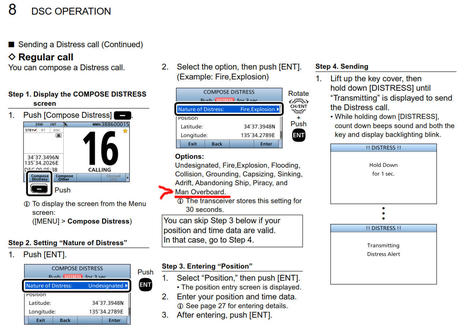 As I expected, the MMSI they were looking for did not match Gizmo's FCC-issued vessel MMSI, which is programmed into the recently discussed Icom M605 that had been powered up throughout the trip, and into a Standard Horizon HX851 handheld that they also wanted to check (even though it had not been touched). It was at about this juncture -- Officer Iaci patiently asking me about other possible radios aboard (there were), me pleading to be on my way -- that I wondered if the problem was really a DSC MOB distress call, which requires several manual steps as shown in the M605 manual above. "Maybe you mean an AIS MOB distress message?" I asked.
As I expected, the MMSI they were looking for did not match Gizmo's FCC-issued vessel MMSI, which is programmed into the recently discussed Icom M605 that had been powered up throughout the trip, and into a Standard Horizon HX851 handheld that they also wanted to check (even though it had not been touched). It was at about this juncture -- Officer Iaci patiently asking me about other possible radios aboard (there were), me pleading to be on my way -- that I wondered if the problem was really a DSC MOB distress call, which requires several manual steps as shown in the M605 manual above. "Maybe you mean an AIS MOB distress message?" I asked.
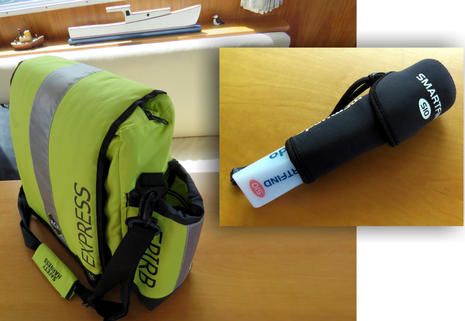 "Geez, I've got four of those onboard," I added, heading forward to grab the ditch bag I'd recently used to organize the various safety devices being long tested. I certainly did not expect any of the beacons to be activated, but when I pulled the McMurdo FastFind S10 out of that big EPIRB pocket, its white translucent end was flashing. It was obviously on, and it was great to find easily-understood Off instructions once the black neoprene cap was pulled back. That's when the Coasties started grinning.
"Geez, I've got four of those onboard," I added, heading forward to grab the ditch bag I'd recently used to organize the various safety devices being long tested. I certainly did not expect any of the beacons to be activated, but when I pulled the McMurdo FastFind S10 out of that big EPIRB pocket, its white translucent end was flashing. It was obviously on, and it was great to find easily-understood Off instructions once the black neoprene cap was pulled back. That's when the Coasties started grinning.
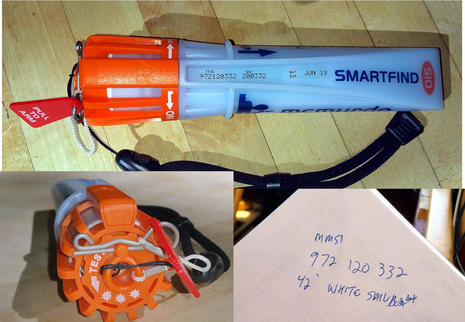 Petty Officer Iaci and Fireman Jansen-Hedrick also got the satisfaction of seeing the S10's preprogrammed MMSI match up with the one they were looking for. Mission accomplished! And I, too, was happy to head back to my mooring, though that's where my embarrassment was compounded by learning that the USCG had tried to contact me by cellphone and even by Facebook. I had some explaining to do, at least to myself.
Petty Officer Iaci and Fireman Jansen-Hedrick also got the satisfaction of seeing the S10's preprogrammed MMSI match up with the one they were looking for. Mission accomplished! And I, too, was happy to head back to my mooring, though that's where my embarrassment was compounded by learning that the USCG had tried to contact me by cellphone and even by Facebook. I had some explaining to do, at least to myself.
How could a boat as elaborately equipped as Gizmo not see an active AIS MOB alert that was very nearby? How did I miss USCG calls on VHF, by phone, and even via Facebook? And right at the top of my list: How the hell did the well-stowed and untouched S10 turn itself on?
Note the S10's hand-grenade-like Pull-To-Arm pin above. In fact, this AIS beacon is especially designed for divers who might get separated from their mother vessel. You could activate it while wearing heavy gloves, even mitts, but not accidentally. The spring-loaded orange top easily twists 90 degrees counterclockwise to turn the device OFF (or test it), but it won't budge clockwise to ON unless the pin is pulled. And it's never been pulled.
I was planning a WTF email to McMurdo until I mentally connected the magnet symbol molded onto the orange top -- it's saying "I'm a magnetic switch" -- to where I'd stowed the ditch bag.
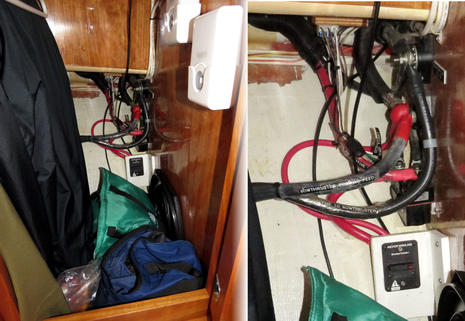 Yup, a couple of weeks ago I stuffed the ditch bag into this forward starboard hanging locker, with the EPIRB pocket up close to those high current bow thruster and windlass cables, as well as the 100 amp circuit breaker. In retrospect I vaguely knew that electromagnetism was possible around such serious 12v power flow -- it's Lenz's Law, according to Alden -- but could there have been enough focused magnetic field to activate the S10?
Yup, a couple of weeks ago I stuffed the ditch bag into this forward starboard hanging locker, with the EPIRB pocket up close to those high current bow thruster and windlass cables, as well as the 100 amp circuit breaker. In retrospect I vaguely knew that electromagnetism was possible around such serious 12v power flow -- it's Lenz's Law, according to Alden -- but could there have been enough focused magnetic field to activate the S10?
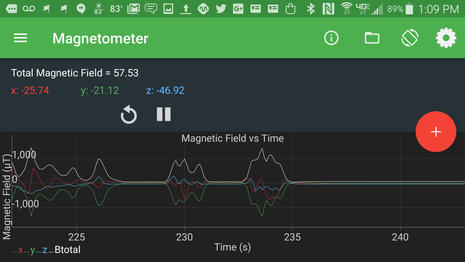 There's an app for that. Actually, there are umpteen magnetometer apps since most smartphones have the needed sensors, but I quickly settled on the Physics Toolbox Sensor Suite and like it so much I purchased the $2.99 pro version. Yes, this is the part of the story where I got to remember how joyful modern technology often is. Even the free version of the Toolbox app let me accurately measure a total magnetic field with its three vector components and collect the results to a .csv file I could instantly save to the GDrive cloud and later turn into telling graphs on a PC.
There's an app for that. Actually, there are umpteen magnetometer apps since most smartphones have the needed sensors, but I quickly settled on the Physics Toolbox Sensor Suite and like it so much I purchased the $2.99 pro version. Yes, this is the part of the story where I got to remember how joyful modern technology often is. Even the free version of the Toolbox app let me accurately measure a total magnetic field with its three vector components and collect the results to a .csv file I could instantly save to the GDrive cloud and later turn into telling graphs on a PC.
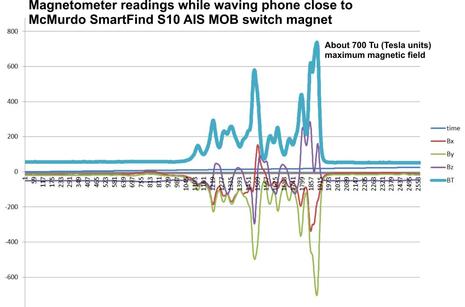 So here's what my new magnetometer saw when I waved the top of the phone an inch or so from the magnet area of the McMurdo S10 beacon. In other words, that's the approximate magnetic force that will turn the S10 on if the pin is pulled and the orange top is turned 90 degrees clockwise so the magnet is over the reed switch. Incidentally, I also learned that I could activate the S10 by direct application of a fairly modest magnet to the right spot (in my basement, and very rapidly turned OFF).
So here's what my new magnetometer saw when I waved the top of the phone an inch or so from the magnet area of the McMurdo S10 beacon. In other words, that's the approximate magnetic force that will turn the S10 on if the pin is pulled and the orange top is turned 90 degrees clockwise so the magnet is over the reed switch. Incidentally, I also learned that I could activate the S10 by direct application of a fairly modest magnet to the right spot (in my basement, and very rapidly turned OFF).
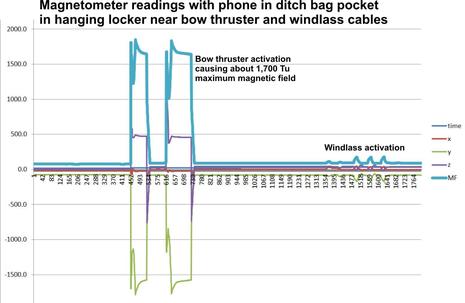 Now here's what happened magnetically when I put the phone in the ditch bag back in the locker and then ran the thruster and windlass intermittently. My inadvertent mission accomplished? Well, that's certainly a relatively significant magnetic burst -- about 2.5 times what I measured from the S10's magnet -- and I had used the thruster briefly getting off the ramp dock, but that timing did not jibe with what I learned from the USCG command center at Sector Northern New England in South Portland.
Now here's what happened magnetically when I put the phone in the ditch bag back in the locker and then ran the thruster and windlass intermittently. My inadvertent mission accomplished? Well, that's certainly a relatively significant magnetic burst -- about 2.5 times what I measured from the S10's magnet -- and I had used the thruster briefly getting off the ramp dock, but that timing did not jibe with what I learned from the USCG command center at Sector Northern New England in South Portland.
It was Petty Officer Nicole Van Gieson, an Operations Specialist in the command center, who had called and attempted to contact me via Facebook, which was not necessarily easy since an AIS MOB beacon is not registered to a boat or a person. I figured that the command center saw the beacon tracking with Gizmo on their AIS monitoring screen, but it was more complicated than that. They got their first report of an MOB alert from another vessel just before noon, with an alert position out by Lasell Island. Gizmo was approximately there on the USCG AIS screen, but it took another report or two to gain confidence that this was an unusual MOB apparently swimming across the Bay at 5 to 10 knots right alongside a Duffy 37 linked to me via its AIS MMSI registration (some of which is public).
Van Gieson explained that while the CG always acts on the worst possible scenario -- "we strive to have a Coast Guard asset en route within 15 minutes of an initial distress call" -- they also try hard to contact boaters possibly in distress to double check. "You would be amazed how many people we have been able to locate safely using Facebook," she later wrote me on Facebook. In fact, she told me she'd been reading Panbo when I called on Saturday afternoon, and was perhaps gently aware that I might be a guy with too many gadgets, even if she just seemed glad that the incident was resolved.
I've heard about this admirable USCG philosophy so many times -- from the CG, and from boaters -- that I believe it's service wide. Of course, they'd like to reduce the huge number of false alarms, and they're rightfully fierce about intentional ones, but they don't presume bad intentions and they want boaters to contact them, even if they're not sure their situation has reached distress level. (Which is also why two-way distress messaging has great value.)
At any rate, knowing that my AIS MOB false alert was called in, not actually seen on AIS at the command center, helps explain the DSC/AIS mixup. But I will note that the USCG, and yours truly, could have realized that an MMSI starting with "972" had to be an AIS MOB beacon, as explained well at the CG's NavCen and often written about on Panbo.
But, wait, if the thruster turned on the S10, why was the first report almost two hours later? My theory: the beacon was only intermittently getting sufficient GPS info in and/or AIS signals out, because it was upside down relative to its desired antenna orientation (plainly marked on the casing) and stuffed in that locker with lots of possible signal obstructions. The theory is somewhat supported by the Marine Traffic screenshot above, which again shows Gizmo's track but also a single last reference to the S10 beacon 972 MMSI, even though I got it much closer to the Lyman-Morse receiving station.
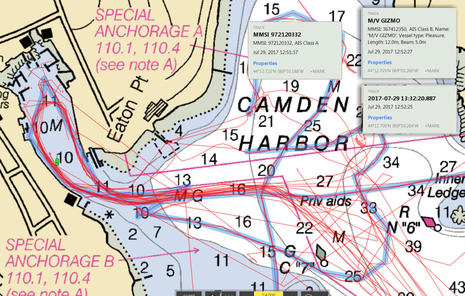 Then I remembered the YDVR log, which led to theory refinement and confirmation. The recorder is on the boat's secondary N2K network, and it not only captured Gizmo's own AIS track being received by the Icom M605, but also the boat's high resolution GPS track and the AIS track of the S10 beacon. That 972 MMSI track starts just after I left the ramp dock shortly before 10am -- thruster activation confirmed -- and ends at the USCG rendezvous.
Then I remembered the YDVR log, which led to theory refinement and confirmation. The recorder is on the boat's secondary N2K network, and it not only captured Gizmo's own AIS track being received by the Icom M605, but also the boat's high resolution GPS track and the AIS track of the S10 beacon. That 972 MMSI track starts just after I left the ramp dock shortly before 10am -- thruster activation confirmed -- and ends at the USCG rendezvous.
But the 972 track is also quite consistent over those three hours, indicating that the S10 did have a GPS lock and was transmitting regularly despite its location. I do think that the transmissions were quite muffled -- otherwise other boats and the USCG would have been on the case sooner and harder -- but the S10 performed pretty darn well in this unplanned test.
McMurdo, incidentally, had never before heard of an accidental magnetic activation of an S10 in its protective pouch, but they were quite interested in this incident and even enthusiastic about its educational aspect. In fact, after looking over my findings, they wrote: "As a result of your detailed analysis of this magnetic field false activation, McMurdo will update our product catalogue to ensure our customers are fully aware of storage and handling best practice."
So maybe I can count that as an unintended mission accomplished, except that I still haven't come clean about my failure to see that the S10 was active.
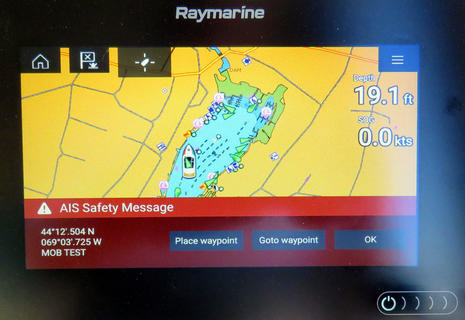 After all, the prime function of an AIS MOB beacon is to alert the boat that it was on before activation, and freaky Gizmo had two AIS receivers and many AIS plotters turned on that day. Plus, as McMurdo justifiably pointed out, one benefit of its new G8 EPIRB with AIS locator is that it could quickly help a boater deal with an accidental activation.
After all, the prime function of an AIS MOB beacon is to alert the boat that it was on before activation, and freaky Gizmo had two AIS receivers and many AIS plotters turned on that day. Plus, as McMurdo justifiably pointed out, one benefit of its new G8 EPIRB with AIS locator is that it could quickly help a boater deal with an accidental activation.
Part one of my answer is easy. Sometimes the always-on Vesper XB8000 AIS transponder does not join Gizmo's main N2K network when it's turned on. I think the behavior is fairly peculiar to this network, and I noticed the lack of targets on the three flybridge MFDs it feeds right away, but I didn't bother to go below and reboot the XB. I could see all the boats fine, anyway, and there was lots of enjoyable socializing going on.
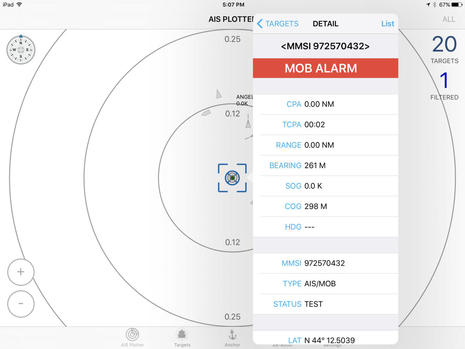 The beautiful day in very familiar waters, the events, and the friends were all part of the bigger distraction issue, but part two of the answer truly makes me cringe. In retrospect, I'm quite sure that I did get an AIS MOB alert, a very loud one, but I shut it down without looking at what it was!
The beautiful day in very familiar waters, the events, and the friends were all part of the bigger distraction issue, but part two of the answer truly makes me cringe. In retrospect, I'm quite sure that I did get an AIS MOB alert, a very loud one, but I shut it down without looking at what it was!
Recall my recent first look at Vesper's brilliant new smartAIS alarming. I'm so not used to its features that when a loud siren went off shortly after I thrusted Gizmo off the ramp dock, my first guess was the Maretron ALM100s, the only alarm system I've encouraged on this potentially way-over-alarmed vessel (until the compelling Vesper update). But there was no sign of alarm on the Maretron displays, and it kept wailing away even when I briefly switched off the N2K network. And, mind you, I was manuevering through a large field of moored yachts from the diminished visibility of the lower helm, while six fresh crew were getting settled or looking over my shoulder for the source of the annoyance.
Finally, I remembered the new Vesper features and had to scramble to open the WatchMate app on the iPad (because I have not yet installed the physical switch I had just recommended). I presumed that it was either an AIS or an anchor drag alarm -- both of which I had recently fooled with -- and went right to the app page where I could mute the siren. But the Vesper XB8000 can also alarm on an AIS MOB message, again even with the app unopened, and I believe I proved that it is almost foolproof!
So many lessons learned. Hopefully, a lot are already obvious, as I've gone on enough, but among the so-far-unmentioned mistakes: I should have had another VHF constantly on channel 16 up on the flybridge, since I often had the Icom CommandMic on the channel used by the parade or race organizers; I should have more than a draft getting-underway checklist of items like rebooting the Vesper (until that glitch is solved); and I should remember that the high incidence of accidents close to home is a real thing. Feel free to add others or compose a list.
Finally, I'd like to apologize to the unknown boaters out on Penobscot Bay whose beautiful July 29th was interrupted by a mysterious and unnecessary AIS MOB alert, and to the USCG who did an exceptional job of handling the incident and yours truly. I believe that the fabulous safety devices we have these days, and the outstanding SAR services they often alert, come with a responsibility to use them properly, including awareness that they are being used.
But, hopefully, this deep analysis of what went wrong will be useful to my fellow boaters, or as the wags at Despair, Inc. note: "It could be that the purpose of your life is only to serve as a warning to others."

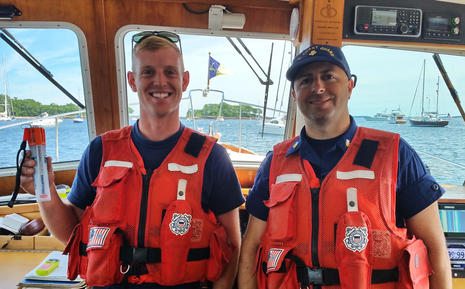
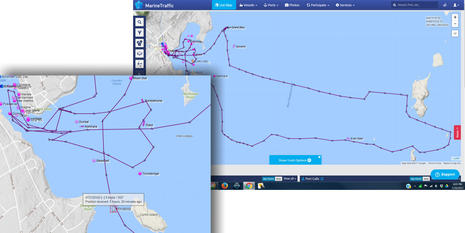

 Share
Share
PS It's occurred to me that I used the bow thruster at least a time or two before this incident with the ditch bag and S10 in the exact same spot. So while I appreciate McMurdo adding a warning in the S10 manual, I think it's hard to do what I did (without trying).
Also, so far I'm not aware other magnetically switched safety devices. Anyone?